|
|
|
Sort Order |
|
|
|
Items / Page
|
|
|
|
|
|
|
| Srl | Item |
| 1 |
ID:
116058
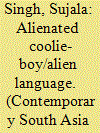

|
|
|
|
|
| Publication |
2012.
|
| Summary/Abstract |
The primary focus of this essay is on the representation of child labour in Mulk Raj Anand's Coolie (1936). I argue that the young-ness of Munoo, the coolie-boy is significant for understanding Anand's social critique of the colonial-capitalist machinery and its reliance upon the sub-waged labour of children and adolescents. It is limiting to read the novel as merely a social critique, however, as it also opens up crucial debates on what it means for an Indian writer writing in English to represent a young ostracised citizen-subject who can hear English and mimic its sounds without having access to an English education. Anand's use of an adolescent is thus significant as an early attempt at foregrounding regional disenfranchisement in English. Through the tropes of listening, seeing, and smelling, and Anand's selective translations and transliterations, I show why Munoo's adolescence matters: it provides a social commentary as well as enabling Anand to highlight the conundrum of representing Munoo's semi-literate, non-English subjectivity into the English language.
|
|
|
|
|
|
|
|
|
|
|
|
|
|
|
|
| 2 |
ID:
097726
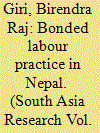

|
|
|
|
|
| Publication |
2010.
|
| Summary/Abstract |
This article highlights that in Nepal, the promise of education seems to have become a magnet of child bondedness. After some government intervention in 2000, the haliya and kamaiya bonded labour practices have become a socially stigmatising matter for adults, and a legal hurdle for kisan (landlord) employers, but the practices continue. Both parties to these bonded labour practices seem to have found the idea of education as a safe meeting point. While parents send their children to work with the hope of obtaining education for them, besides other material benefits, employers seek to pay as little as possible and will often not give sufficient time to their young workers to study. Though most children have little or no say during the contract, they, too, are initially attracted by the promise of education. Based on detailed fieldwork, this article explores to what extent the largely unfulfilled educational aspirations for Musahar and Tharu working children can be seen as a restrained form of empowerment or a continuing system of bonded labour in Nepal.
|
|
|
|
|
|
|
|
|
|
|
|
|
|
|
|
| 3 |
ID:
147430


|
|
|
|
|
| Summary/Abstract |
This paper considers the relationship between child labour and a child's academic achievement in rural China. Using a unique longitudinal, multi-level survey, the Gansu Survey of Children and Families (GSCF) which was enrolled in the Gansu province, I use a quasi-maximum likelihood estimation (QMLE) and find that more than 1 h of child labour in the previous time period has a negative effect on a child's academic achievement in the subsequent period after controlling for child talent. I also show that previous academic achievement has no strong significant effect on current child labour by applying a logistic model. Based on the data, the fact that those effects are not very big or not significant suggests that child labour in China is not a big problem when compared with other developing countries (Bacolod & Ranjan 2008).
|
|
|
|
|
|
|
|
|
|
|
|
|
|
|
|
| 4 |
ID:
065126


|
|
|
| 5 |
ID:
068624
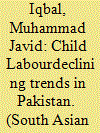

|
|
|
| 6 |
ID:
122835


|
|
|
|
|
| Publication |
2013.
|
| Summary/Abstract |
While it may be intuited that human trafficking is an ineluctable component of the child soldiering experience, very little research exists to illustrate the tangible connections between these two 'worst forms' of child labour. The extent to which common reception points for trafficked children-such as slave-owning households, religious boarding schools and brothels-double as profitable reservoirs for recruiting commanders remains entirely unknown. Likewise, despite the clear financial incentive that some erstwhile commanders might have to traffic their former child combatants into civilian slavery, the prevalence of such practice is unknown. The purpose of this article is to delineate some of the most conspicuous academic gaps pertaining to the intersection of child trafficking and child soldiering.
|
|
|
|
|
|
|
|
|
|
|
|
|
|
|
|
| 7 |
ID:
092383
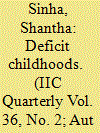

|
|
|
| 8 |
ID:
106650


|
|
|
|
|
| Publication |
2011.
|
| Summary/Abstract |
Drawing on the relevant literature, this article explores key debates and controversies on child labour in the context of Africa and Asia. It first identifies and analyses three dominant discourses on child labour: 1) the work-free childhoods perspective; 2) the socio-cultural perspective; and 3) the political economy perspective. Against the backdrop of these discourses, the article goes on to critically examine aspects of child labour that are underrepresented in the literature and in international policy circles. It concludes by highlighting the importance of grounding children's gendered work within the complex material social practices of interconnected histories and geographies in which their livelihoods unfold.
|
|
|
|
|
|
|
|
|
|
|
|
|
|
|
|
| 9 |
ID:
157767
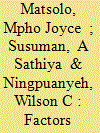

|
|
|
|
|
| Summary/Abstract |
The purpose of this research is to investigate and analyse higher education institutions’ enrolment and drop-out rates within the Gauteng province, South Africa. Large-scale secondary data from the General Household Survey, obtained from Statistics South Africa (2012) were used. This study’s findings show that finance, orphan-hood, transport to the higher education institutions and, to a lesser extent, unplanned pregnancies, are some of the main factors that affect the enrolment rate of students. This study hopes to be useful to policy-makers, research managers and other decision-makers within the higher education (HE) landscape.
|
|
|
|
|
|
|
|
|
|
|
|
|
|
|
|
| 10 |
ID:
106502
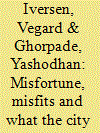

|
|
|
| 11 |
ID:
073520
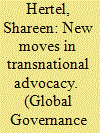

|
|
|
|
|
| Publication |
2006.
|
| Summary/Abstract |
Activists involved in human rights advocacy across borders may share common interests in changing the status quo¾but they do not always agree on the rights centrally at issue, nor the best strategy for promoting and protecting them. This is particularly true in campaigns in which "economic rights" claims emerge. Two new mechanisms I develop in this article shed light on the complexities of transnational advocacy and norms evolution. Two case studies offer insights into the operationalization of the mechanisms: a campaign to prevent child labor inBangladesh, and a campaign to prevent employment discrimination against pregnant workers in Mexico.
|
|
|
|
|
|
|
|
|
|
|
|
|
|
|
|
| 12 |
ID:
152309


|
|
|
|
|
| Summary/Abstract |
A recent child-work study by the International Labour Organization reports that 27% of children in Tajikistan ages 5–17 worked in 2013. Although children worked in agriculture or performed household chores in Soviet Tajikistan, child work for pay is a relatively new phenomenon in modern Tajikistan. This study examines the pathways to child work and the families’ perceptions of child work experiences. Some of the main findings of this study are the themes connected to normalization and acceptance of child work in Tajikistan. These are explained by expectations placed on children at the social, family and personal levels that are in turn affected by macroeconomic forces that are by-products of the transitional economy. The study also explores differences in expectations by gender, age and area of residence.
|
|
|
|
|
|
|
|
|
|
|
|
|
|
|
|
| 13 |
ID:
192314
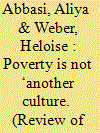

|
|
|
|
|
| Summary/Abstract |
Well-being and protection of all children have widely been associated with universal rights. Simultaneously, though, there is growing advocacy for a right of children to work to live. Drawing on cultural relativist premises, such advocacy strongly correlates with an acceptance of poverty as a condition that is inevitable or simply ‘given’. We advance an argument against a right of children to work to live. The fact that only poor children are compelled to work should direct analyses to the causes of poverty. A critical engagement with the politics of development is necessary as it is often constitutive of relations of impoverishment. We critique Eurocentric perspectives that advocate for child labour and substantiate our argument by drawing on the case example of Bolivia, which lowered the legal age for child labour, only to eventually retract this decision. We demonstrate the link between neoliberal development and a rapid increase in the number of children forced to work to live since the 1980s. The case for a right of children to work to live is not justifiable; but there is a case for abolishing child labour and upholding the right of all children and their families to live in dignity. Poverty is not ‘another culture’.
|
|
|
|
|
|
|
|
|
|
|
|
|
|
|
|
| 14 |
ID:
065383
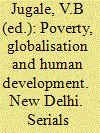

|
|
|
|
|
| Publication |
New Delhi, Serials Publications, 2005.
|
| Description |
xi, 506p.
|
| Standard Number |
8186771573
|
|
|
|
|
|
|
|
|
|
|
|
Copies: C:1/I:0,R:0,Q:0
Circulation
| Accession# | Call# | Current Location | Status | Policy | Location |
| 050081 | 338.9/JUG 050081 | Main | On Shelf | General | |
|
|
|
|
| 15 |
ID:
182473
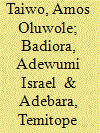

|
|
|
|
|
| Summary/Abstract |
Against the background of the solution-defying incidence of child labourers in Nigerian cities, this study examined the relationship between public spaces and incidence of child labourers in Ibadan Municipality, Nigeria. Data were obtained through direct counting of child labourers and cursory observation of the physical and environmental compositions of their places of operation. The direct counting was conducted for seven days of the week in the morning, afternoon and evening within defined activity-nuclei purposively selected across three densities of residential areas of the municipality: high, medium and low. The data collected were subjected to descriptive statistics. Findings showed that the incidence and categories of child labourers varied with public spaces and density of residential areas, and also followed the concentric, sector and multiple nuclei theories of urban land use. The study, therefore, recommended that urban planners and government have roles to play in offering lasting solution to the menace of child labour.
|
|
|
|
|
|
|
|
|
|
|
|
|
|
|
|
| 16 |
ID:
140447
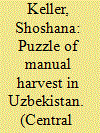

|
|
|
|
|
| Summary/Abstract |
Uzbekistan has attracted international criticism for its use of child labour, defined as labour performed by youth under the Soviet legal limit of 16, to harvest cotton by hand. This article argues that manual labour, mostly performed by low-status children and women, became entrenched in Central Asian agriculture during the 1950s, and investigates the possible reasons for its persistence in the face of global trends to the contrary. The timing is a puzzle, because the 1950s were when mechanization of agriculture became a global development goal. The USSR participated in the mechanization trend. To understand better the roots of rural labour patterns in the Khrushchev period, we must consider how economic incentives and disincentives, gender relations, demographics, and state policy worked together.
|
|
|
|
|
|
|
|
|
|
|
|
|
|
|
|
| 17 |
ID:
080818
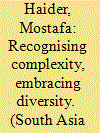

|
|
|
|
|
| Publication |
2008.
|
| Summary/Abstract |
The diversity of children's work and life across the world has generated intense debates on the socio-legal status of working children, particularly in countries of the South. Official legal systems often accord little recognition to working children, while in practice they encompass a distinct yet complex entity. This article examines the tensions between official international and national laws and the actual reality or 'living laws' regarding working children in Bangladesh in a wider interdisciplinary context. While these children are mainly so impoverished that they have to work for their own survival, to deny them any agency in negotiating their position seems misguided. Thus it is argued that the present dominant understanding of child work is not compatible with the real life situations of such children and is, in fact, injurious to their individual interests. The article suggests that a culture-specific analysis which properly diagnoses the contextual struggles of working children in countries like Bangladesh is better suited to minimising the ongoing suffering of working children
|
|
|
|
|
|
|
|
|
|
|
|
|
|
|
|
| 18 |
ID:
101300
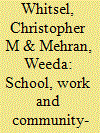

|
|
|
|
|
| Publication |
2010.
|
| Summary/Abstract |
Youth in Tajikistan and Afghanistan struggle to attend secondary school. Educational research indicates that individual, family and community factors are key determinants of educational participation. The question that dominated past research was whether family or community variables had a greater influence on educational participation. Instead, this article asks how the community context shapes the influence of family characteristics on educational participation. Using recent data from the Tajikistan Living Standards Measurement Survey and Afghanistan National Risk and Vulnerability Assessment, we demonstrate ways that school availability, school costs and work opportunities shape individual and family determinants of youth educational participation in Tajikistan and Afghanistan. We find that there is greater divergence between communities in Tajikistan than in Afghanistan.
|
|
|
|
|
|
|
|
|
|
|
|
|
|
|
|
| 19 |
ID:
131376
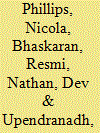

|
|
|
|
|
| Publication |
2014.
|
| Summary/Abstract |
The resilience of the problem of child labour in the global economy has been amply documented, but, we suggest, the reasons for this situation have not yet been fully captured in the associated debates. Our aim is to advance a way of thinking about those forms of child labour which occur in the context of global production networks (gpns), and to contend that greater attention must be paid to the organisation and functioning of gpns, and the social foundations on which they rest, if we are to grasp more fully the conditions and processes which facilitate the persistence and evolution of child labour. The way of thinking we propose is rooted in the concept of 'adverse incorporation' in the global economy, which we develop by drawing together currents in gpn analysis and poverty research to explore the commercial and social dynamics in gpns which give rise to these forms of labour exploitation. We illustrate our arguments with reference to the garments industry in New Delhi, India.
|
|
|
|
|
|
|
|
|
|
|
|
|
|
|
|
| 20 |
ID:
100907
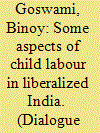

|
|
|
|
|
|
|
|